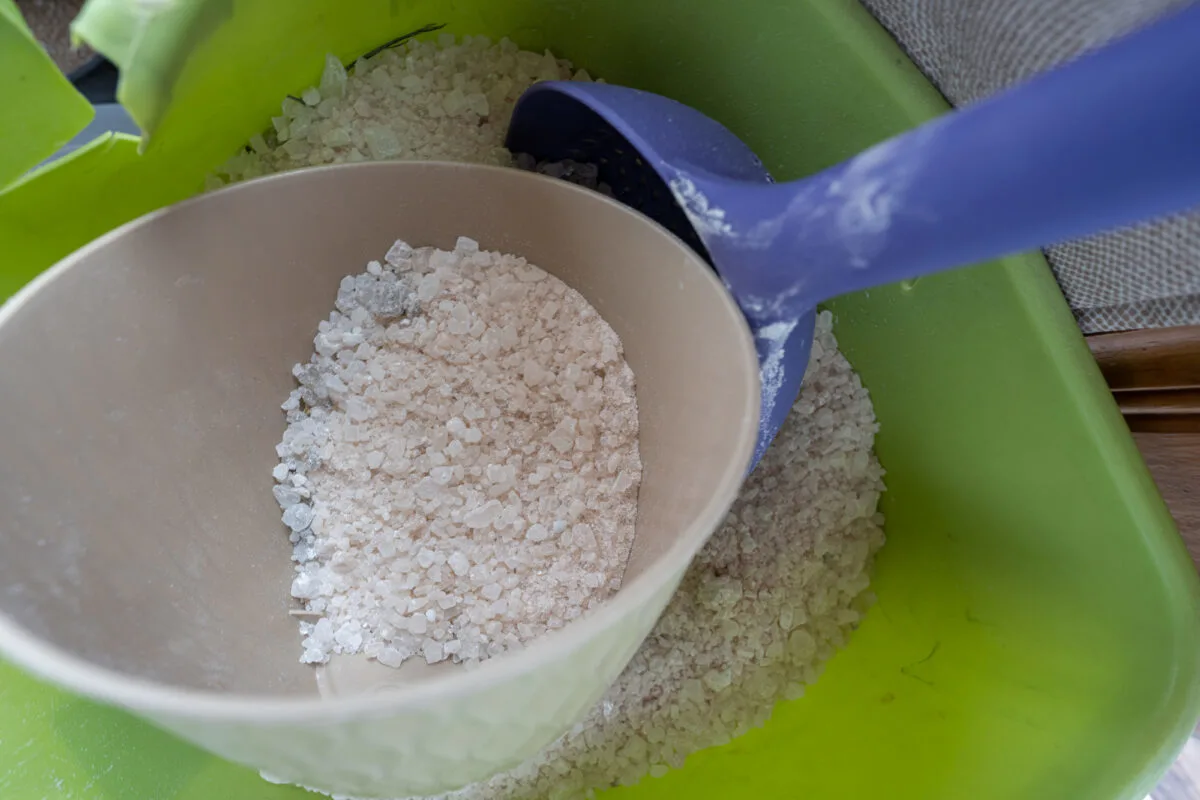Rock salt is used around the world to help prevent ice and snow from building up on roads and sidewalks. It is an easy way to melt snow and ice without needing the physical strength to shovel or scrape snow. The salt is also wise to use to prevent slipping and falling on sidewalks, porches, balconies and driveways that might have invisible ice that can be a danger.
Rock salt benefits include:
- Works effectively in temperatures as low as -6 degrees
- Is easy to store
- Easy to apply
There are a lot of different types and brands of rock salt available. You might have heard that some aren’t safe for pets, and others can damage surfaces. Here is everything you need to know about using rock salt on snow so that you can buy the right type.
The Difference Between Rock Salt and Table Salt
While table salt and rock salt are the same things in terms of chemical structure, the form that they take and their uses differ greatly.
The biggest difference between table and rock salt is the size of the granules. Rock salt has significantly larger granules, making it much more effective when gritting a road, as it will dissolve at a lower rate.
Another major difference between rock salt and table salt is the additives. Table salt tends to contain more additives, such as iodine, because it is intended to be used for cooking. Rock salt generally has more anti-caking agents, so that it does not stick together when sitting in a bag for a long time. The anti-caking agents make it easier to spread.
Best Rock Salt For Snow
The most reliable place to purchase rock salt is from your local home improvement store. They can help you pick the best rock salt for your needs and your local weather conditions.
If you cannot make it to a store, online retailers offer the same products. (It’s just wise to get free shipping offers when shipping a product this heavy, though. That’s where Amazon Prime comes in handy.)
Regardless of what brand of rock salt you buy, you will always want to see which one has the highest concentration of pure salt. Purity is essential because the higher the level of salt, the lower temperature it will work at, and the better it will be at creating traction.
Marine salts like magnesium chloride usually have a purity of 99.9% and tend to dissolve quickly while not leaving behind any grit once the snow is gone.
Overall, the best type of rock salt to buy is one containing calcium chloride, which works at the lowest temperature. Like magnesium chloride and sodium chloride, calcium chloride absorbs nearby moisture and creates an exothermic reaction, which warms the surrounding snow and helps it melt quicker and more efficiently.
It also doesn’t stain like normal sodium chloride does, which is important in case you spill some on your clothes or carpet.
All types of rock salt are hygroscopic, meaning they absorb water particles in the near vicinity, allowing them to work even faster.
Morton’s Safe-T Salt
One of the most popular rock salt brands in the U.S. is Morton’s Safe-T-Salt. This rock salt is relatively inexpensive and melts snow at temperatures as low as five degrees Fahrenheit. This rock salt is also useful when cars are stuck in snowdrifts, providing excellent traction for tires.
Morton also has a Snow and Ice Melt that is Safe for animals, Morton Safe-T-Pet.
Green Gobbler Pet Safe Ice Melt
Green Gobbler Pet Safe Ice Melt Fast-Acting Treatment works even better, but does come with a higher price tag.
This rock salt costs over twice as much as Morton’s Safe-T-Salt but will melt snow at temperatures as low as -10 degrees Fahrenheit. This could be very important if you live where temperatures get very cold.
This brand’s pellets contain magnesium chloride, an extract of sea salt.
This type of salt is safer for the environment and will not harm or irritate your pet on contact. The more eco-friendly magnesium chloride is also less likely to damage your driveway.
What Temperature Does Rock Salt Become Ineffective?
One critical factor in applying rock salt is knowing what temperature it stops working. In general, your standard sodium chloride-based rock salt will help create traction at temperatures as low as -6 degrees. However, most halite rock salts stop efficiently melting ice at a much higher temperature. Traditional rock salt will stop melting ice at 15 degrees, as it is unable to break down water molecules in such icy conditions.
When attempting to melt ice and snow at temperatures below 15 degrees, it is wise to buy a calcium chloride or a high concentration magnesium chloride-based de-icer. These rock salts work at much lower temperatures than sodium chloride (calcium chloride as low as -25 degrees).
How To Apply Rock Salt Effectively and Efficiently
Another crucial factor is knowing the best way to apply rock salt to your driveway, road, or sidewalk. If you know there is snow heading your way, the best thing to do is to spread your rock salt out before the snow begins to fall. This way, you can get a head start on melting the snow and avoid any potential injury from slipping over while applying your rock salt in frosty conditions.
It is also very important that you keep an eye on the temperature to make sure you are not applying rock salt unnecessarily. Halite rock salts stop working around 15 degrees, and cold northern winters regularly dip below this temperature. If you only have standard rock salt and you are looking to create traction, a great cheap alternative is cat litter.
If snow is falling thick and fast, you may want to use a different tool to clear your driveway. Rock salt only works on thin layers of snow and is unlikely to melt compact coverings. You may want to use a shovel or snow blower to remove the majority of snow before applying rock salt to soak up the rest.
Here are other ways to remove snow without a shovel or snow blower.
You can also apply rock salt to densely packed snow to help break it up, making it simpler to remove with a shovel.

You will want to make sure you disperse your rock salt evenly, so it does not end up all in one place. If you are spreading your fertilizer by hand, one of the simplest ways to make sure you get an even coating is by shaking out of a cup or tin can. This hand-held salt spreader is the perfect solution for applying the ice melt.
The best method for applying rock salt is with a spreader. Salt spreaders make sure you get an even distribution while giving you better control than using a shovel or cup.
You will find salt spreaders are less labor-intensive, too. This is perfect for anyone suffering from back pain or chronic injury. If you do not have a purpose-built spreader, you can also use a fertilizer spreader. Most fertilizer spreaders have an adjustable chute, which can accommodate most rock salt pellets.
Using more rock salt doesn’t mean it will melt more snow. It is best to use a thin, even coating. You should use about four pounds of rock salt per 1,000 square feet. If you have any salt leftover after the snow has melted, the chances are you’ve used too much.
Top Tips For Using Rock Salt Safely
Rock salt of all kinds can be harmful to the environment, potentially seeping into nearby rivers, lakes, and swamps and damaging the ecosystem. Even a small amount of rock salt can cause a lot of destruction, so make sure you clean up and dispose of any rock salt left behind.
Rock salt can also be harmful to pets. While most magnesium chloride and calcium chloride-based rock salts won’t irritate your pet’s skin, all rock salts are toxic to animals if ingested. If your pet ingests rock salt, they could suffer from vomiting, disorientation, fatigue, and even salt poisoning.
Ensure you take safety precautions when handling rock salt by wearing gloves, as it can cause skin and eye irritation. The best way to dispose of your rock salt waste is by transferring it into a sealable plastic container, and then taking it to a nearby waste management center.
Suitable Surfaces For Rock Salt
While rock salt is superb for removing snow and ice, there are few things to keep in mind before using it on certain surfaces. Sodium chloride-based rock salts are inexpensive but can cause potholes and structural damage to sidewalks, driveways, and roads. Usually, all types of rock salt will leave a salt residue if used frequently, even on asphalt, wood, gravel, and tiling.
There are a few surfaces you don’t want to apply rock salt on. Metal is subject to salt corrosion when exposed to salt and water, causing rust and ruining the metal’s finish and integrity. As a result, you should move your vehicle out of the way while applying de-icer to your driveway, as salt will corrode your vehicle’s metal parts, wrecking the finish.
Avoid applying rock salt to your lawn or garden. High concentration rock salts are toxic to most plants and will kill flowers and grass.
Over time, rock salt will cause some damage to most surfaces if applied often. It is best used sparingly.
Be sure to check out all of our helpful Emergency Preparedness articles for dealing with snow and ice.
What Can I Do With Rock Salt At The End Of The Winter Season?
You may find yourself with a lot of rock salt left over when the winter ends. Thankfully, salt is a mineral and it won’t spoil as long as you store it in a sealed container and a dry place. This rock salt storage bin comes with a pour spout for easy use during the winter.
You can also sweep up and store salt left behind on your driveway, which will save you money and prevent buying more salt the following year.
Want more winter weather help? Here are some of our popular articles for dealing with snow and ice:

